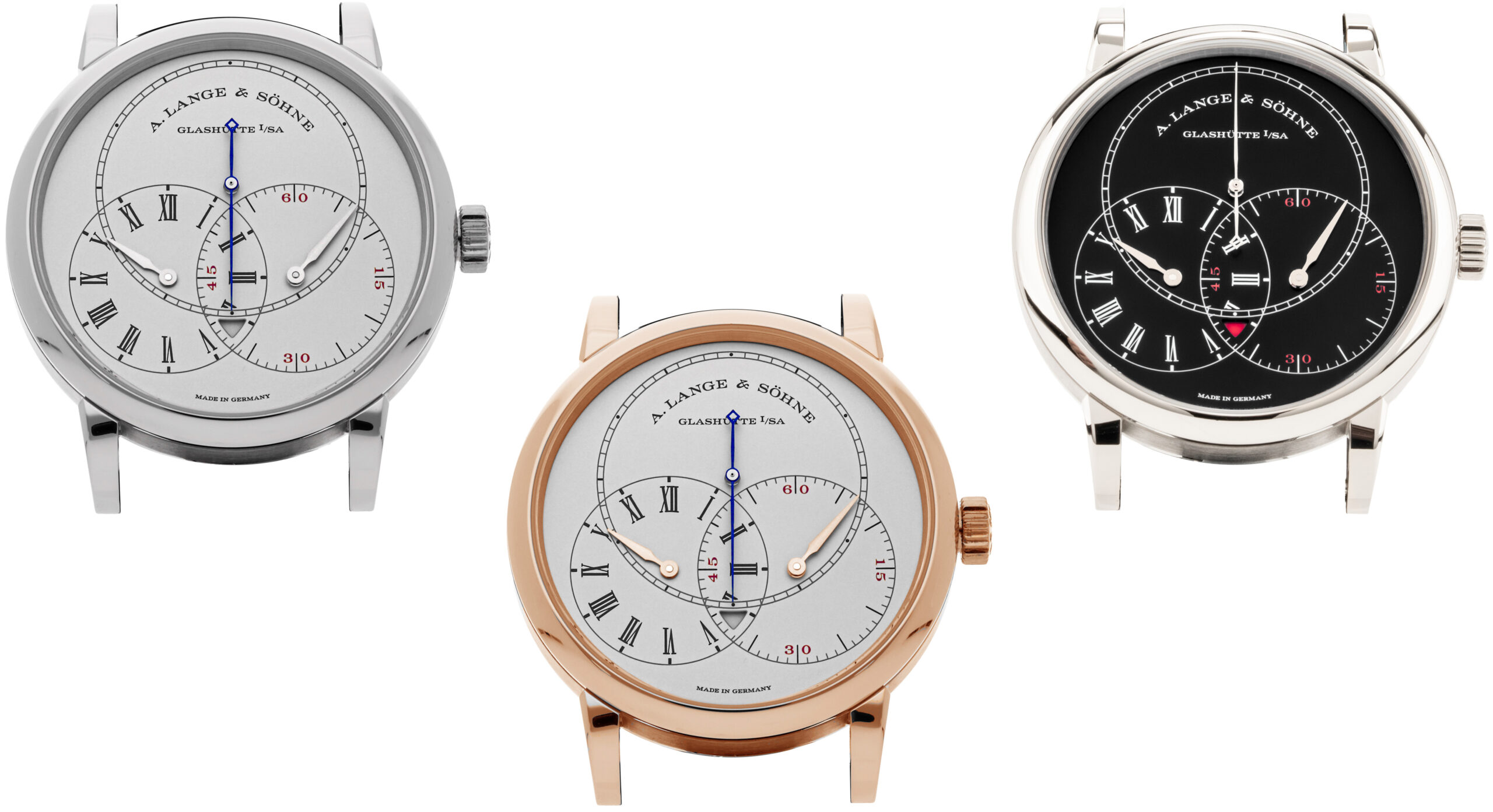
All three Richard Lange Jumping Seconds. Sold at @WatchBox
Understanding Richard Lange Jumping Seconds
March 2024
A. Lange & Söhne is a free brand, liberated from the constraints of its watchmaking past. It isn’t compelled to adhere to tradition or heritage, but rather, it takes responsibility for innovating on its own terms. While the brand occasionally draws from its rich history, it remains unbound by it. Dubbed the biggest independent brand at one point, A. Lange & Söhne truly deserves this title, showcasing one of the boldest approaches to design and watchmaking among established high-end brands. The Richard Lange Collection serves as concrete evidence of this assertion, with the Richard Lange Jumping Seconds timepiece standing out as one of its finest and most challenging pieces to understand.
The introduction of the collection goes back to 2006. A time only piece set onto the watchmaking scene, first time with a center second for the brand. Heavily inspired from the pocket watches of the 19th century, as its name would suggest, the Richard Lange collection was introduced as an ode to accuracy and technical challenges. Something that the brand’s namesake founder would approve and proud of! In the end, Richard Lange himself is a paramount figure in improving the accuracy of mechanical watches with pivotal touches on the balance systems. You can read more on the Richard Lange page, here.
Ever since, the Richard Lange collection has expanded in shapes and complications that most of us would not imagine. In 2007, the introduction of the ReferenzUhr marked a magnificent ode to the early days of timekeeping and how time was transferred to distant villages. 2009 brought us the Richard Lange Pour le Merite, designed for the most sophisticated watch collector, featuring marvelously executed enamel on the front and a fusee & chain on the back. 2011 saw the arrival of the Richard Lange Tourbillon Pour le Merite with a pivoting dial. Perhaps a bit gimmicky, but i cannot help to think if an independent had done this, the earth would have shattered. Alas, the trend now is making three-handers with a nicely finished movement… Then we have the Terraluna in 2014, simply the sky on your wrist where you can track the movement of the earth, moon, and sunlight, along with all the date functions you need for a lifetime.
Recommended Reading: Richard Lange
Even though all these watches are magnificent from a watchmaking perspective, most are a bit crowded and confusing on the dial, especially post-2011. As a very dear friend puts it: simultaneously non-classical and non-inventive. It was only in 2016 that Lange took the Richard Lange Collection to its essence: timekeeping at the forefront with a simple layout. The Richard Lange Jumping Seconds is a piece worth understanding, with fantastic captures by my friend @polinoir. I hope to do exactly that!
The Precise Case
Peculiar measurements this one has… At 39.9 mm in diameter and 10.6 mm in thickness, one might ask why such increments? Yet, this gem was made to be an ultimate precision instrument, and indeed, it starts with the case!
Constructed in the classic A. Lange & Sohne fashion, over three-steps with the soldered and faceted lugs, the case is the perfect embodiment of the highly engineered stance of the Richard Lange Jumping Seconds. One more delightful thing on this case is the thin bezel. It gracefully opens the simple yet funky dial, putting the jumping seconds and the signature regulator arrangement on a pedestal.
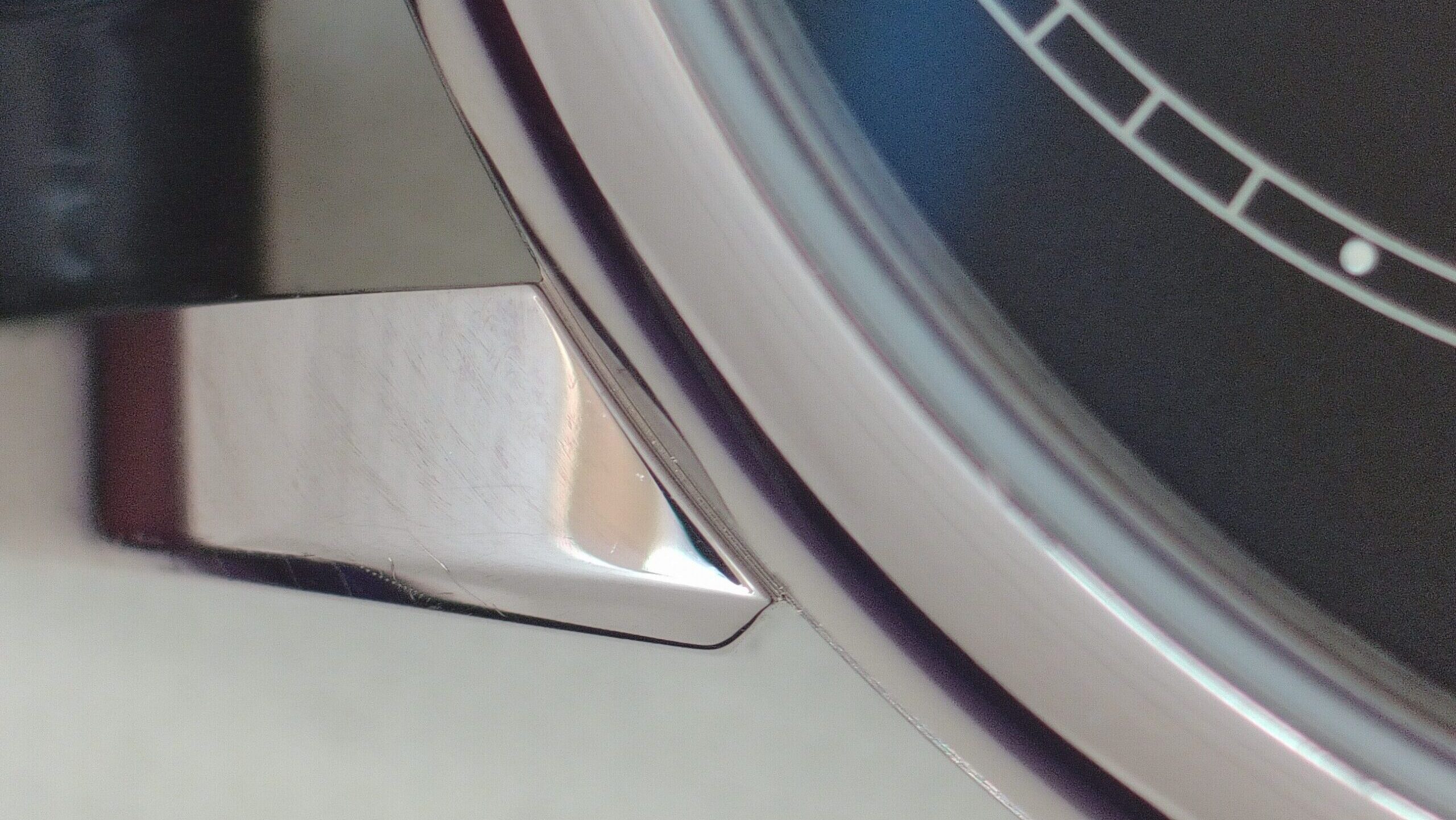
Richard Lange Jumping Seconds in white gold. Courtesy of @polinoir
Throughout its rather short life, we have seen the Richard Lange Jumping Seconds in three metals: Platinum, pink gold and white gold, in that chronological order. I think it is done a bit too many, but what do I know.
While the platinum (252.025) and pink gold (252.032) references are limited to 100 pieces each, the white gold example with black dial is without limitation, other than the manufacture’s capabilities.
150 Years Old, Still Young
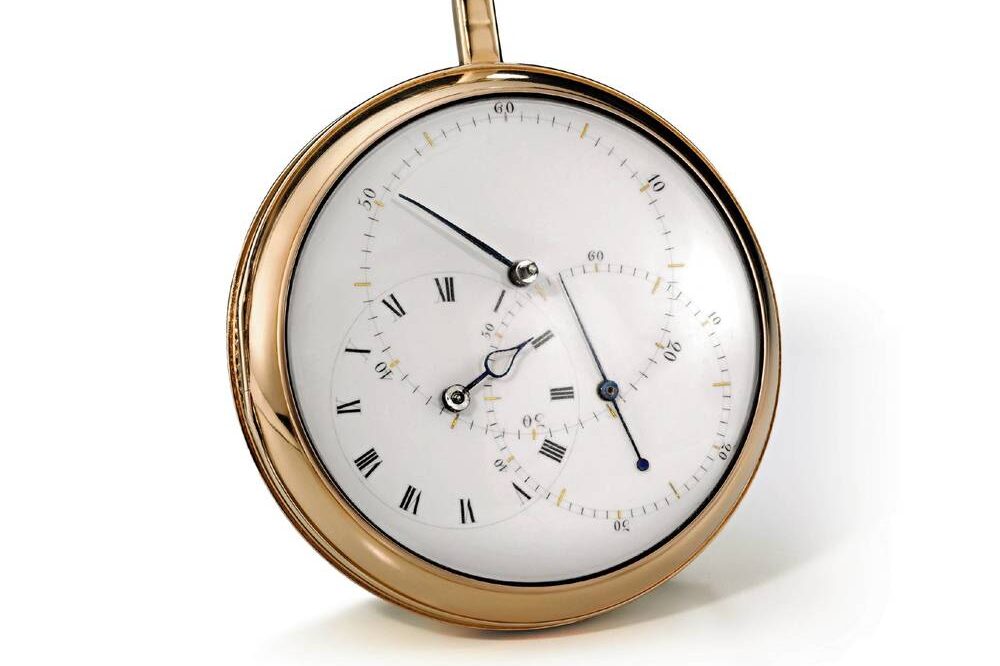
Seyffert’s No.93 Pocket Watch
In Seyffert’s pocket watch, the minute hand covers the largest space, whereas the hours and seconds are placed in the bottom two sub-dials. However, the Richard Lange Jumping Seconds is not merely a lazy copy – or in watch industry terms, an “inspiration.” In the wristwatch version, we see the seconds take center stage, in line with the ultimate precision claim of the caliber L094.1. In return, we get to see the exact alignment of each second’s marker with each tick of the seconds hand, affirming the brilliant adjustment of the remontoire mechanism.

Richard Lange Jumping Seconds 252.025. Courtesy of Lange Uhren GmbH
Each sub-dial features a distinct design. Roman numerals adorn the hour sub-dial, paying homage to Richard Lange’s personal pocket chronometer, while an open track displays minute markers to balance the dial’s layout. The seconds sub-dial boasts an emphasized railway minute track, further distinguishing it from the rest. Moreover, in the platinum edition, the seconds hand is crafted in blued steel against a silver background, adding to the visual delight.
The presentation of the power reserve indication is another charming aspect of the Richard Lange Jumping Seconds. Instead of traditional hands or circles, the power reserve indicator is represented by a small, curved triangle positioned just below the convergence of all three sub-dials. As the watch is wound, the power reserve transitions from red to white, offering an innovative and aesthetically pleasing touch that aligns perfectly with the watch’s overall design concept.
For those interested in further reading, the Datograph Perpetual Tourbillon, introduced in 2016, is another exceptional timepiece that shares a similar approach to its power reserve indication. It seems that 2016 was a pivotal year for Lange, marked by a focused effort to update both the complications and designs of their timepieces.
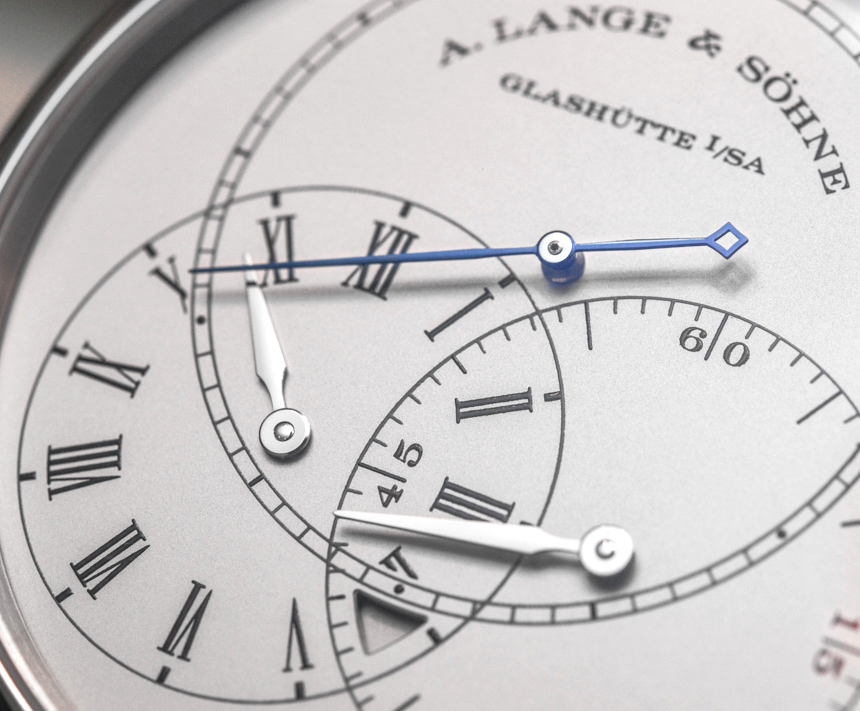
Richard Lange Jumping Seconds 252.025. Courtesy of Lange Uhren GmbH
Now, all this talk brings us to the “why” of Richard Lange Jumping Seconds.
Richard Lange Jumping Seconds Caliber L094.1
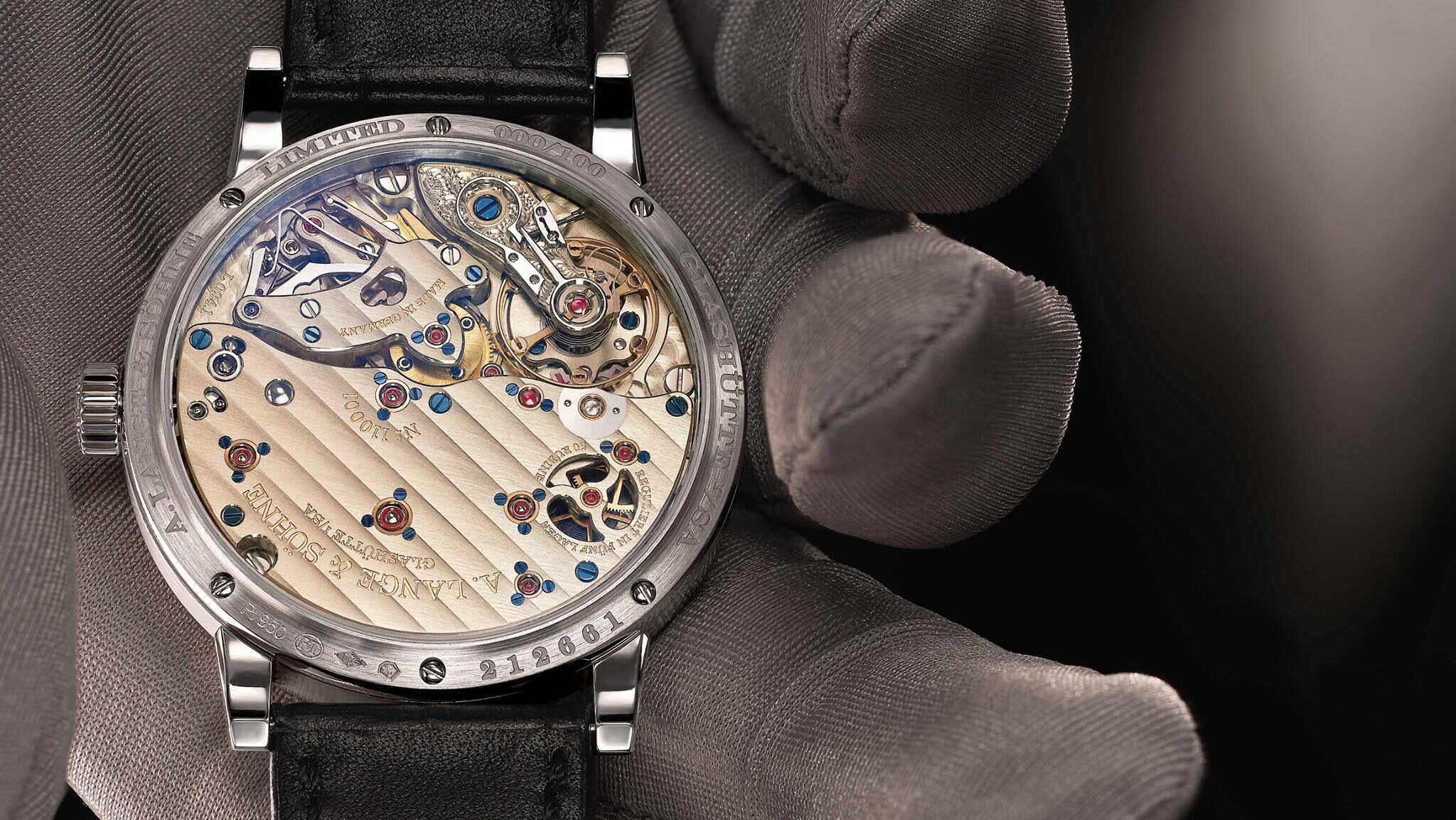
Richard Lange Jumping Seconds Caliber L094.1. Courtesy of Lange Uhren GmbH
No matter how many complications are fitted into a watch in a rather small space, the mechanics must maintain correct timekeeping. Whether I’m operating a repeater while running a split-seconds chronograph during a calendar change, that watch should not lose its amplitude or experience any malfunctions. There was a time when regleurs commanded the utmost respect. Watchmaking was primarily about timekeeping, and these individuals were the stars at observatory competitions. However, with the advent of quartz, that claim and profession began to fade…
Yet, with restructuring, the watch industry transformed into a luxury industry, prioritizing collectability and human craftsmanship above all. This time, we began to see complications crafted to enhance precision even further, aiming to close that 5-second daily gap. In this regard, the Richard Lange Jumping Seconds is a magnificent tribute to both watchmaking and its namesake inspiration, who dedicated his life to precision mechanics.
A. Lange & Söhne’s history of experimenting with torque delivery dates back to its inception. In 1994, the Tourbillon Pour le Mérite was the world’s first wristwatch with the fusee and chain mechanism. Subsequently, we witnessed the Lange 31, offering 31 days of power reserve, and of course, the legendary Zeitwerk in 2009 – what I call the second renaissance of Lange!
The history of the remontoire can be traced back further to John Harrison’s spring remontoire. The principle is rather simple. The mainspring carries enough tension to run the watch for days. As you may know, it is the unwinding of the mainspring that powers the gear train and eventually the escapement to move the hands and show time. However, as the mainspring unwinds and due to its weight, there are fluctuations in the torque delivered to the escapement. Similar to a toy car released upon tension, it starts fast but loses its torque towards the end of its power. The remontoire spring, on the other hand, is much lighter than the mainspring and is free from any variations or friction in the going train. Furthermore, the remontoires unwind frequently (in every second in the case of the Richard Lange Jumping Seconds), thus delivering virtually even power throughout the power reserve.
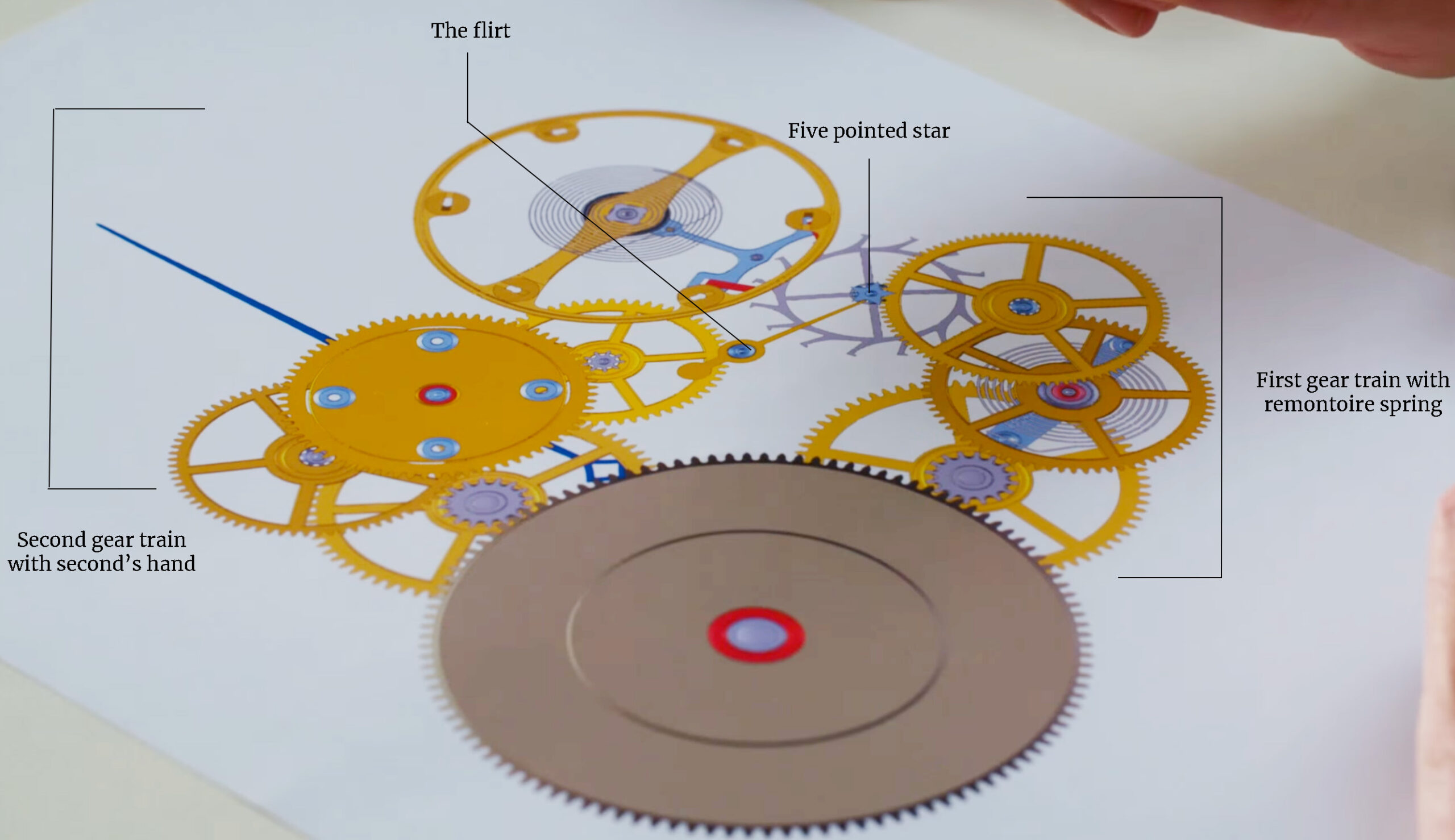
Richard Lange Jumping Seconds Caliber L094.1. Courtesy of Lange Uhren GmbH
So, how does it work?
There are two separate gear-trains in Richard Lange Jumping Second’s caliber L094.1. The first gear train is powering the balance wheel. This is also the train that carries the blue remontoire spring. The spring unwinds every second to deliver even torque to the escapement. But how does it know the second?
That relates to the second gear-train which the second’s hand is connected. The 5-star pinion on the escape wheel is in contact with a lever called flirt of the second’s hand. The jumping seconds mechanism converts the six semi-oscillations of the balance into one step per second. After each full second, one of the tips of the star (beneath the sapphire jewel) liberates the tensioned flirt. Following, the flirt swiftly rotates by 360 degrees before it is stopped by the next tip of the star. This in return allows the remontoire spring to unwind every second with a constant force each time.
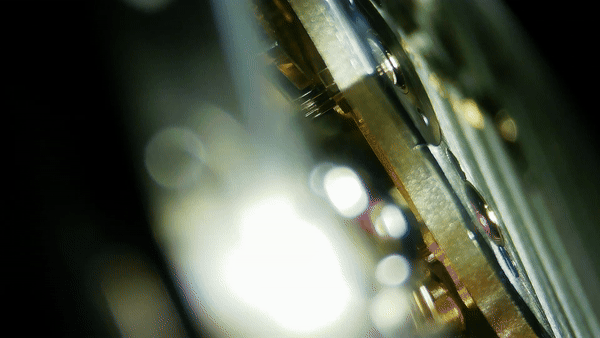
The flirt ticking each second. @polinoir
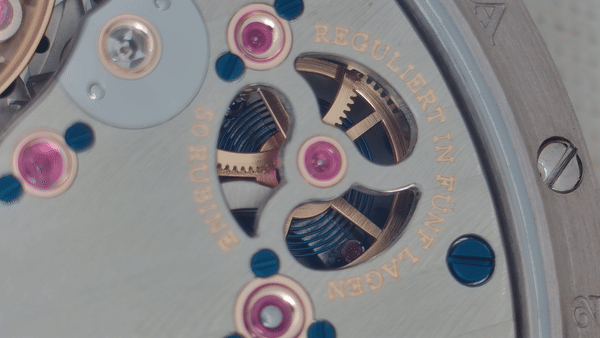
The spring releases each second. @polinoir
But it does not stop there…
Like all Richard Lange collection pieces, you are always going to have something extra and the Richard Lange Jumping Seconds, does not disappoint.
The already complex caliber L094.1 also offers a zero-reset mechanism. A complication that is almost synonymous with Lange now. First offered in 1997 with the Sax-0-Mat, it is just extra sauce of the finest Lange movements.
The zero-reset mechanism is a rather complex one. It takes a pair of masterful hands to build and adjust the delicate, active parts. Possibly that’s the reason we do not see it anymore in the basic Saxonias, which makes the earlier Langematiks incredible value. Sigh, that’s another topic!
The problem with putting a zero-reset mechanism to Richard Lange Jumping Seconds is the rather big seconds hand, hence its inertia. Therefore, the caliber L094.1 utilizes a multidisc clutch to overcome the force of start and reset. When the crown is pulled, the arresting spring gently stops the balance and the clutch discs are separated via a clamp, disconnecting the seconds hand from the wheel train.
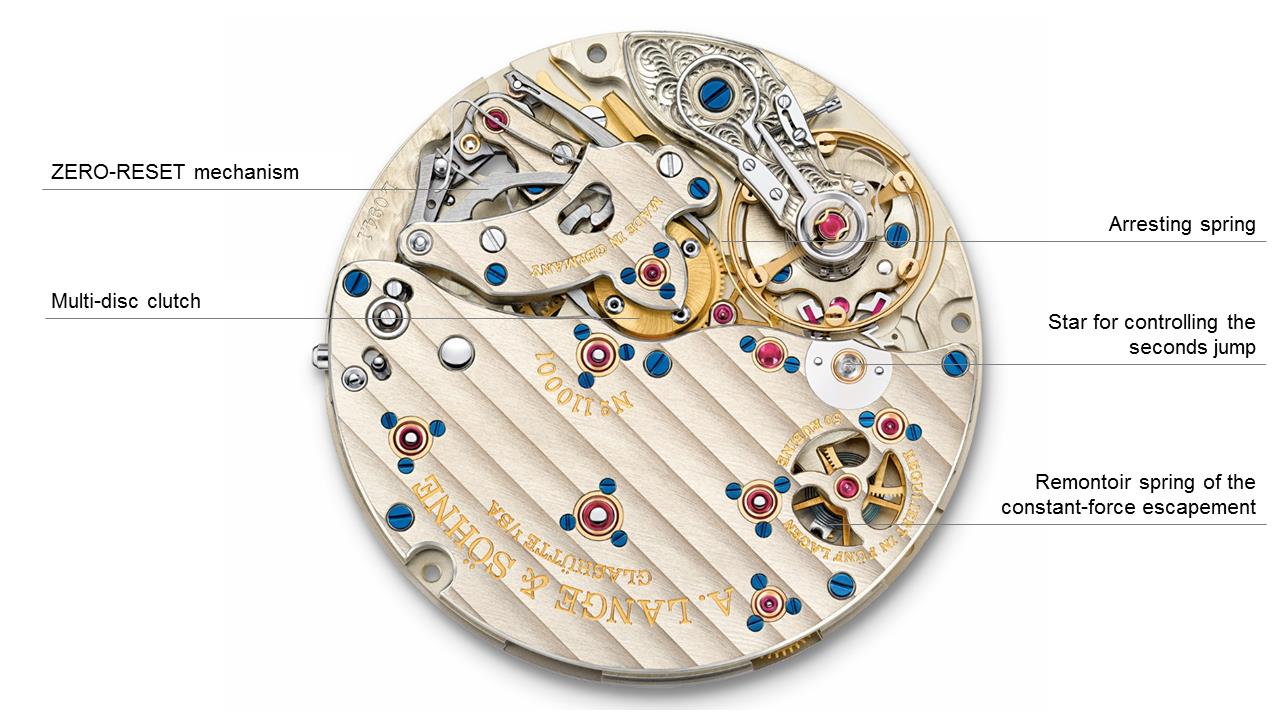
Richard Lange Jumping Seconds Caliber L094.1. Courtesy of Lange Uhren GmbH
As with its mechanics and design, the finishing of the Richard Lange Jumping Seconds caliber reveals itself in small details. At first glance, one might overlook the three-quarter plate on this rather complicated piece, similar to the 1815 Tourbillon. I often wonder why we don’t see more complexity and intricacy in these expensive pieces. However, upon closer inspection, one can appreciate the meticulous handwork.
The anglage around the edges of the three-quarter plate is executed in a typical Lange manner. It surpasses the standards of most mainstream and famous brands, though it may be a bit more reserved than that of your favorite independent watchmaker. Nevertheless, it is finely angled and beautifully presented. The ribbing, the polishing of screws and chatons, as well as the escape-wheel cap and swan’s neck regulator, are all delightful as usual. I simply adore Lange’s approach to movement finishing. It’s designed to impress anyone, and that is no easy feat!
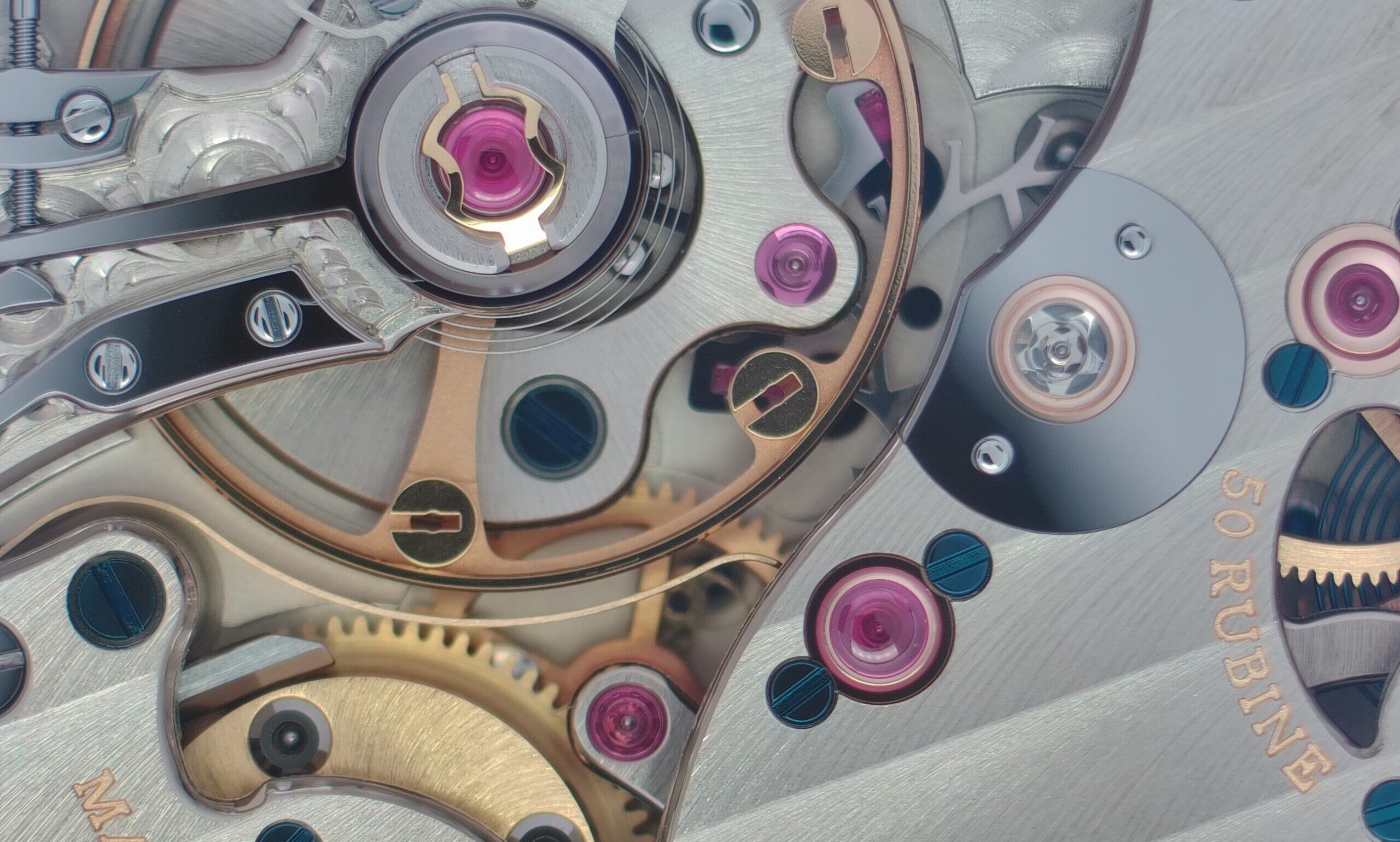
The flat-polished regulator, escape wheel cap, and a myriad of gorgeous finish and colors. @polinoir
For enthusiasts like us, we just need to get a bit closer and that’s where @polinoir’s macros enter the chat. A sharp inward angle masterfully done on the bridge, accompanied by delightful curves and another sharp corner up ahead. As we look more, we can see the functional parts, such as the zero-reset lever, are straight grained whereas the wheels are finished with solarization technique. On the edges, we see circumferential graining, beautifully contrasting against the high polish on the anglaged surfaces.
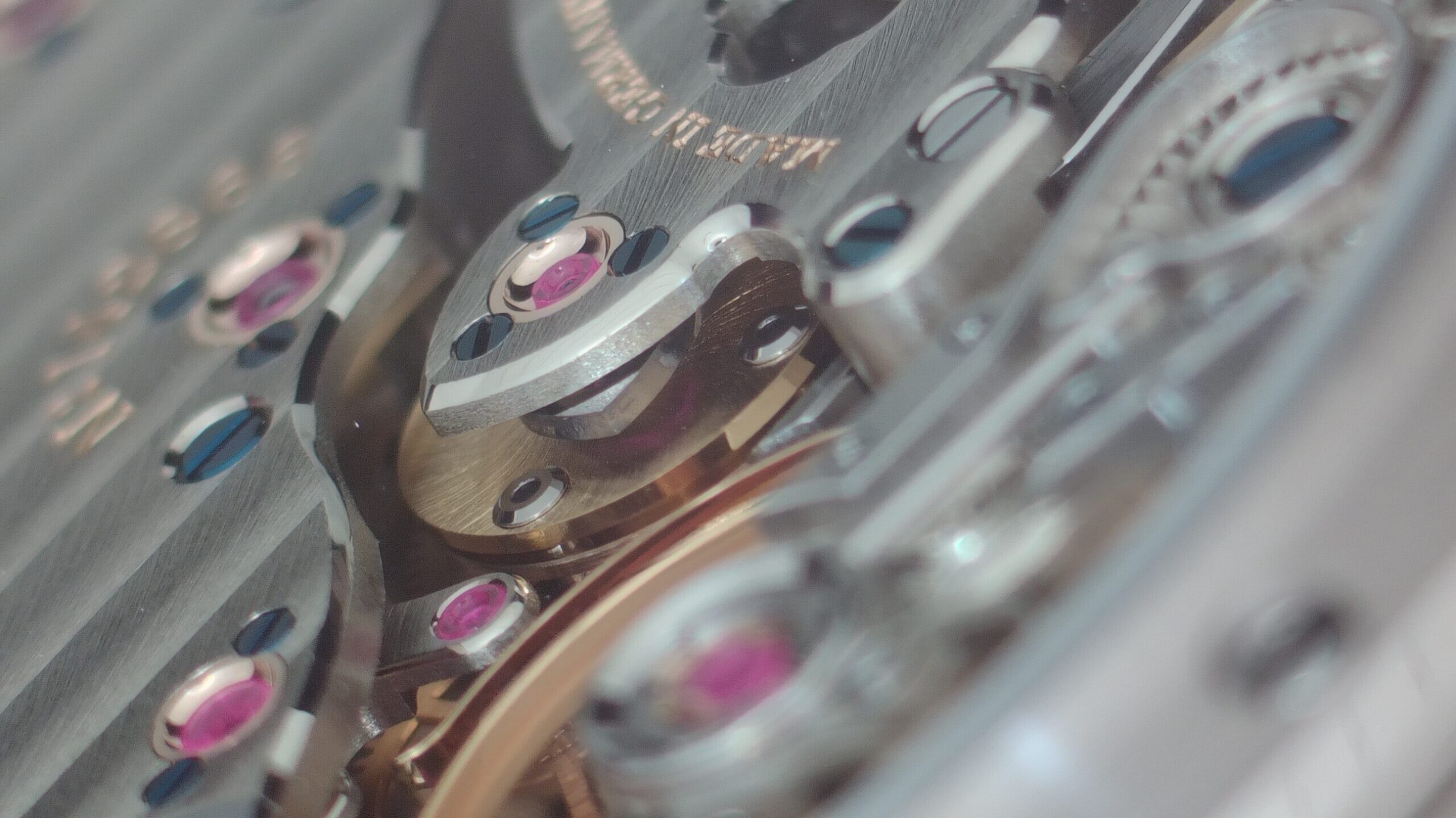
The depth. @polinoir
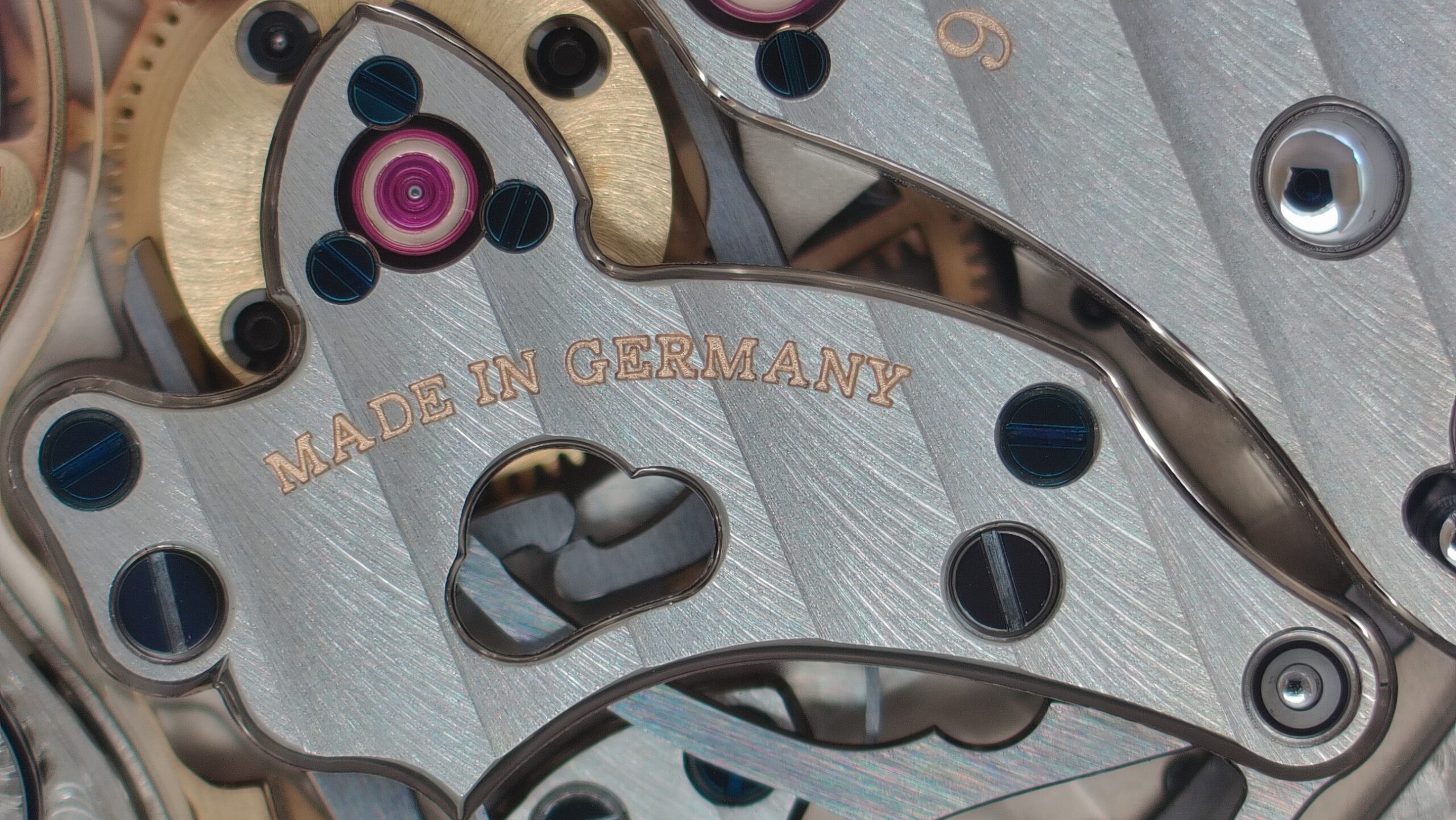
The multi-disc clutch, and zero reset mechanism.
All in all, the caliber L094.1 of Richard Lange Jumping Seconds is nothing short of a work of art. You have that exquisite engineering one would expect from Lange, and that human touch that is hard to capture in big brands. From hand-engraving to the color harmony, to hand-polished corners the caliber L094.1 just sings to its owner, and only to those who know. None other.
Conclusion & Buying a Richard Lange Jumping Seconds
I think the best word to describe the Richard Lange collection would be “confused.” Perhaps it’s trying too hard to be different. There’s no denying the incredible watchmaking and craftsmanship evident in all the pieces, but sometimes they come off as gimmicky. Take the Terraluna, for example. It’s a fantastic piece with a 14-day power reserve, constant force mechanism, celestial moon phase accurate to 1,058 years, and an instantaneous perpetual calendar on the back. However, at 45 x 16.5 mm, it’s more of a statement piece. I can’t help but wonder if other watchmakers could achieve similar feats at that size. Additionally, why do we need three watches based on Seyffert’s pocket watch? While some collectors may appreciate the idea of completing the Seyffert collection, it is surely not for me.
On the other hand, the Richard Lange Jumping Seconds offers something special and versatile. It boasts a brilliant movement with a historic inspiration, it’s aesthetically pleasing and distinctive without being overly flashy, and it’s wearable. Overall, it’s a great watch, and an even better deal in the pre-owned market.
Upon its launch in 2016, the platinum version was priced at $82,500, with the last known retail price being $84,500 in 2020. Today, a white gold example will set you back about $97,800, following significant price increases in the last two years. However, the market doesn’t always follow retail prices.
As of March 2024, you can easily find a platinum limited edition example for around $65-70k, depending on the condition, and the black dial variants even lower than that. At Lange, there are abundant choices in this price range, and unfortunately, the Richard Lange Jumping Seconds is not always the first one that comes to mind.
A sincere thank you to my dear friend and the collector extraordinaire @polinoir for supplying me with such amazing captures and also to Lange Uhren GmbH for the technical details.
I hope this was a valuable guide for whomever is looking for a Richard Lange Jumping Seconds or just want to learn the details and history of these pieces. If you’d like to chat, sell or buy a Zeitwerk Date, please kindly reach out to me via [email protected]
Please feel free to contact:
Follow Langepedia on Instagram:
Watch “A. Lange Story” Documentary, in partnership with WatchBox:
FAMILIES / COMPLICATIONS
STAY IN TOUCH
Sign up for the newsletter to get to know first about rare pieces at Marketplace and in-depth articles added to the encyclopedia, for you to make the most informed choice, and first access!
